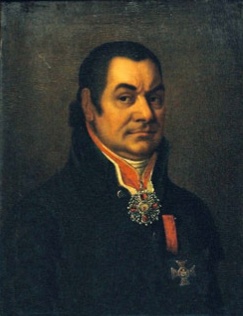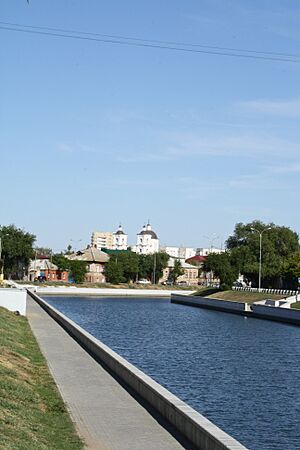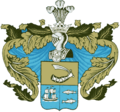Ioannis Varvakis facts for kids
Quick facts for kids
Ioannis Varvakis
Ιωάννης Βαρβάκης |
|
|---|---|

An oil portrait of Varvakis
by Vladimir Borovikovsky |
|
| Native name |
Ιωάννης Βαρβάκης
|
| Birth name | Ioannis Leontidis (Ιωάννης Λεοντίδης) |
| Nickname(s) | Varvakis (Βαρβάκης) |
| Born | 24 June 1745 Psara, Eyalet of the Archipelago, Ottoman Empire (now Greece) |
| Died | 10 January 1825 (aged 79) Zakynthos, United States of the Ionian Islands (now Greece) |
| Buried |
First Cemetery of Athens
|
| Allegiance |
|
| Service/ |
|
| Rank | First Lieutenant |
| Commands held | St. Andrew |
| Battles/wars | Russo-Turkish War (1768–1774)
|
| Awards | |
Ioannis Varvakis (Greek: Ιωάννης Βαρβάκης; 1745–1825) was a brave Greek sailor and businessman. He was also known as Ivan Andreevich Varvatsi (Russian: Иван Андреевич Варваци) in Russia. Ioannis was a privateer, which means he owned a private ship that was allowed to attack enemy ships during wartime. He was also a generous person who gave a lot of money to help others, and he was part of a secret group called the Filiki Eteria that worked for Greek independence.
Contents
Who was Ioannis Varvakis?
Ioannis was born on the Greek island of Psara in 1745. His parents were Andreas Leontis and Maria Moros. His real name was Ioannis Leontides. The nickname Varvakis came from his childhood. People thought his eyes looked like the eyes of a bird of prey called a varvaki (which is an Eleonora's falcon) that lived on his island. His mother later became a nun on the island of Chios. Sadly, she passed away during the Chios Massacre in 1822.
A Hero in the Orlov Revolt
Ioannis Varvakis was a Greek Orthodox Christian. By the age of 17, he was a very skilled sailor. He built his own ship, which he named St. Andrew. He offered his ship and crew to the Russian forces during a war against the Ottoman Empire (1768–1774).
He spent all his money to prepare his ship with cannons. He showed amazing courage during the Battle of Chesma in July 1770. His ship was turned into a "fire ship." This meant it was filled with things that could burn easily, set on fire, and then steered into a large Turkish ship. This was a very risky but effective tactic.
Even though Ioannis fought bravely, Greece did not gain independence from the Ottoman Empire after this war. A peace treaty was signed in 1774. However, this war did cause many Greeks to move to Russia.
Working for Catherine the Great
After the war, Ioannis Varvakis had no money left. He decided to meet with Catherine II of Russia, who was the Empress of Russia. He traveled to Saint Petersburg. There, he met with a powerful general named Grigori Alexandrovich Potemkin, who helped him get an audience with the Empress.
Catherine the Great was very generous to Varvakis. She gave him 1,000 golden roubles as a gift. She also gave him permission to fish as much as he wanted in the Caspian Sea without paying taxes. He could also choose any place in Russia to live. On October 21, 1772, he officially became a first lieutenant in the Russian Navy. His new Russian name was Ivan Andreevich Varvatsi.
Becoming a Millionaire in Astrakhan
With his new opportunities, Ioannis Varvakis moved to Astrakhan. He started a fishing business, even though he had no experience. His business in the northern Caspian Sea made him a millionaire! His boats caught valuable fish like sturgeon and white salmon.
He knew that Greeks loved caviar (fish eggs). He found a way to export caviar to Europe. He invented special wooden boxes that kept the caviar fresh during long ship journeys. These boxes were waterproof and kept the precious eggs in excellent condition. Before this, caviar was usually stored in caves. Varvakis shipped caviar from Astrakhan to Greece by camel or by boat through the Volga river. By 1788, his business employed over 3,000 workers.
From 1810 to 1817, Ioannis Varvakis paid for the building of a channel. This channel connected the Volga river to one of its branches, the Kutum River. It was first called "Astrakhansky" but was later renamed "Varvatsievski" in his honor. After the Russian Revolution, it was renamed "The May 1st Channel."
Life in Taganrog
In 1810, Alexander I of Russia gave Varvakis the title of hereditary nobleman. This meant his family would have a special status and a coat of arms. He also received important awards for his great services.
In 1812, he moved to Taganrog, a city with many Greek settlers. In 1813, Ivan Varvatsi spent 600,000 rubles to build the Greek Jerusalem Monastery in Taganrog. When Emperor Alexander I died in Taganrog in 1825, his funeral service was held in this monastery.
Varvatsi's large house in Taganrog was badly damaged during a war called the Crimean War. It was hit by many cannonballs and rifle bullets. The building was later nicknamed "house with bullets" because the walls were left with the marks of the battle.
Returning to Greece
Ioannis Varvakis strongly supported the Greeks during the Greek Revolution. He especially helped his home island of Psara. After the Turkish Fleet destroyed the island, he returned to Greece in 1824 to help the people who had lost their homes. He passed away on the island of Zakynthos on January 10, 1825.
Varvakis wanted to help educate young people in the new Greek state. In his will, he left 1 million rubles to build a high school. This school was named Varvakeio (Βαρβάκειον Λύκειον) in his honor. Varvakis also paid for the building of Athens' main market, which is called the Varvakeios Agora.
Varvakis' Family Legacy
Ioannis Varvakis did not have any sons. He wanted his family name to continue. So, he asked Catherine the Great if his first daughter, Maria Varvakis, could have a double surname. This meant she would use both her father's name, Varvakis, and her husband's name, Komnino. Catherine II agreed, and this created the noble family of Komnino-Varvatsi.
All of Maria and Nikolay Komnino-Varvatsi's sons were given noble titles in 1821. This was to honor the great achievements of their grandfather, Ioannis Varvakis. Later, their descendants married into other Greek-Russian families.
Remembering Varvakis
In the 19th century, a street in Taganrog was named after Varvakis. It was called Varvatsievsky Lane. Later, in the 1920s, it was renamed after the poet Mikhail Lermontov.
In 2012, a statue honoring Varvakis was placed in the city of Astrakhan.
A film called God Loves Caviar was made in 2012. It tells the story of Ioannis Varvakis and his invention for transporting caviar. The German actor Sebastian Koch played Varvakis in the movie. However, the film has some historical mistakes, like showing the wrong emperor ruling during the Greek Revolution.
Images for kids














